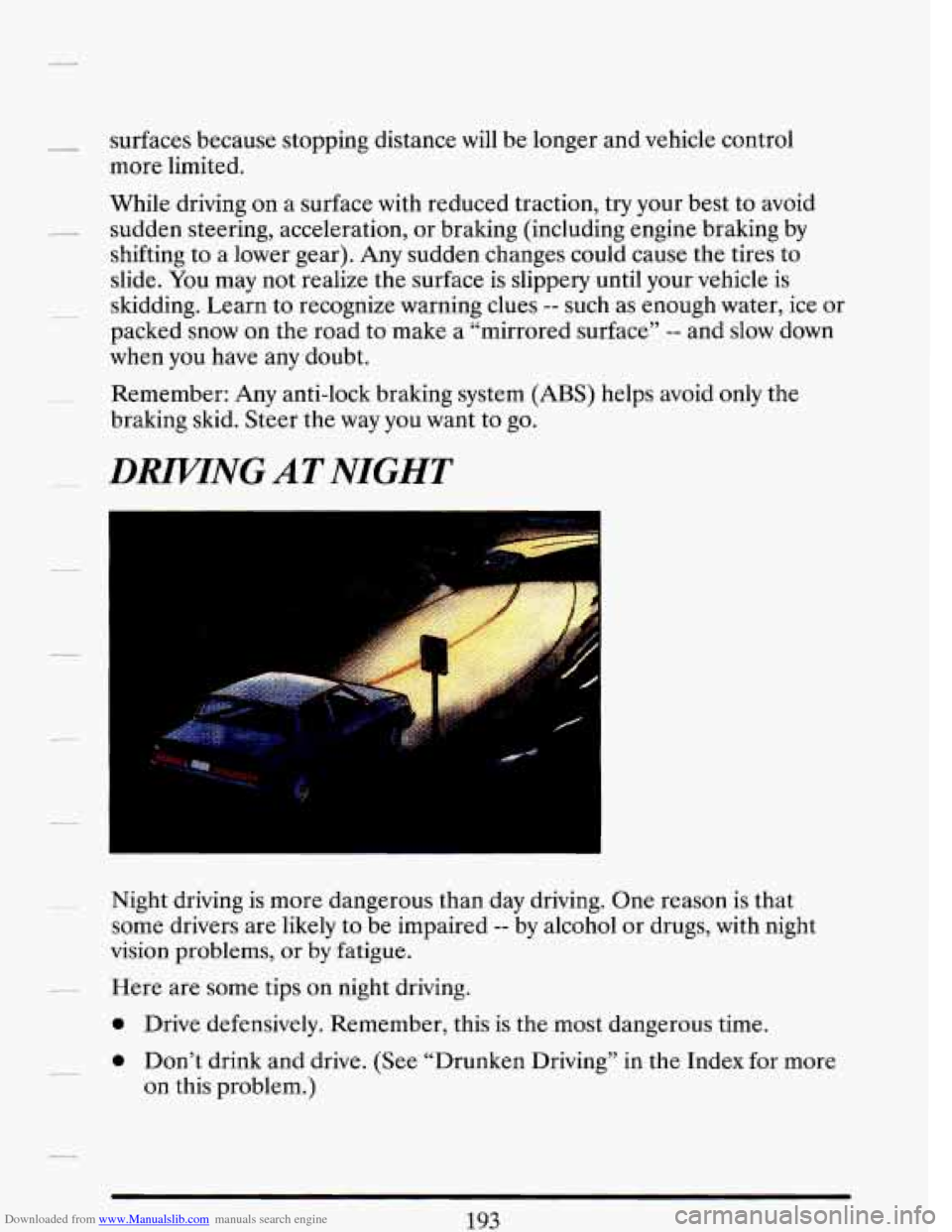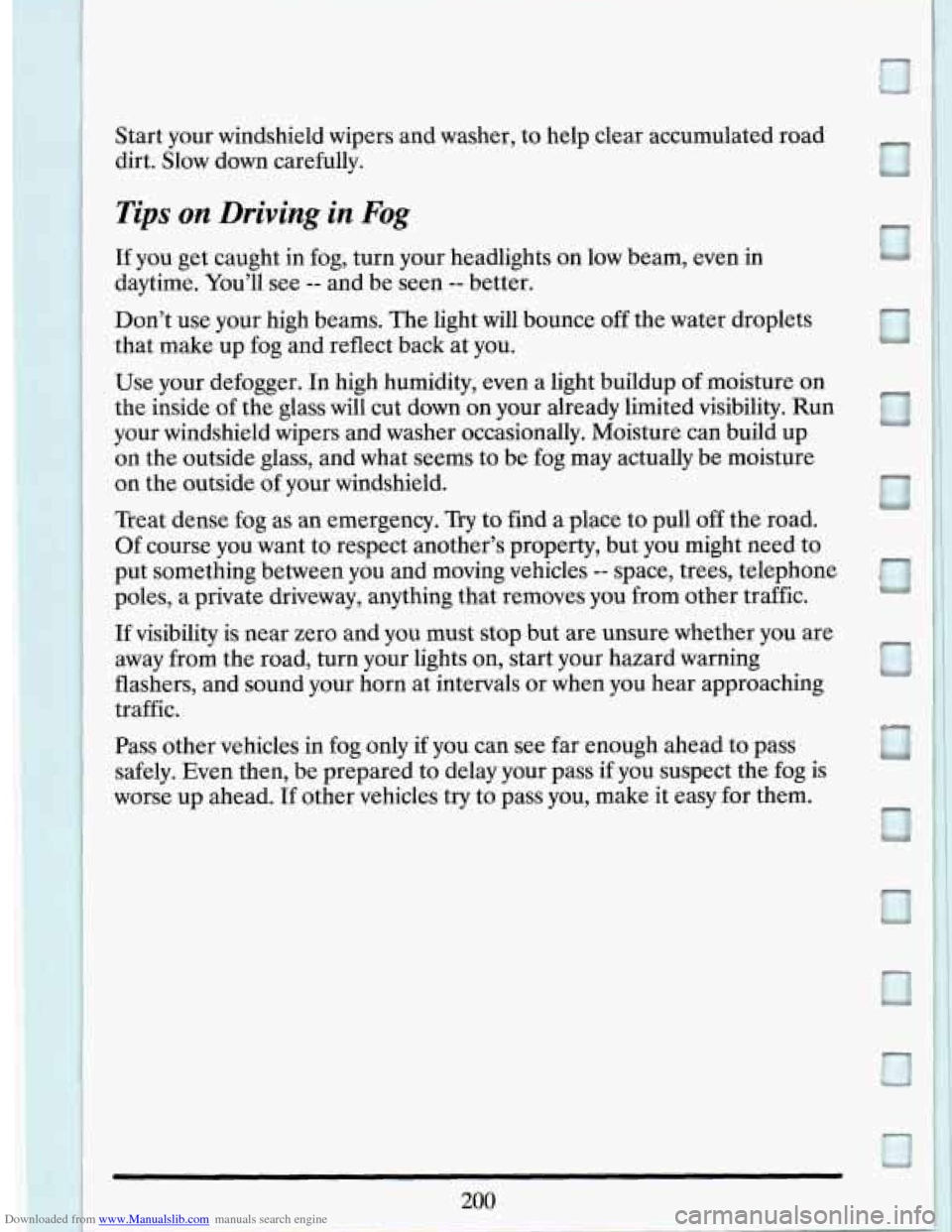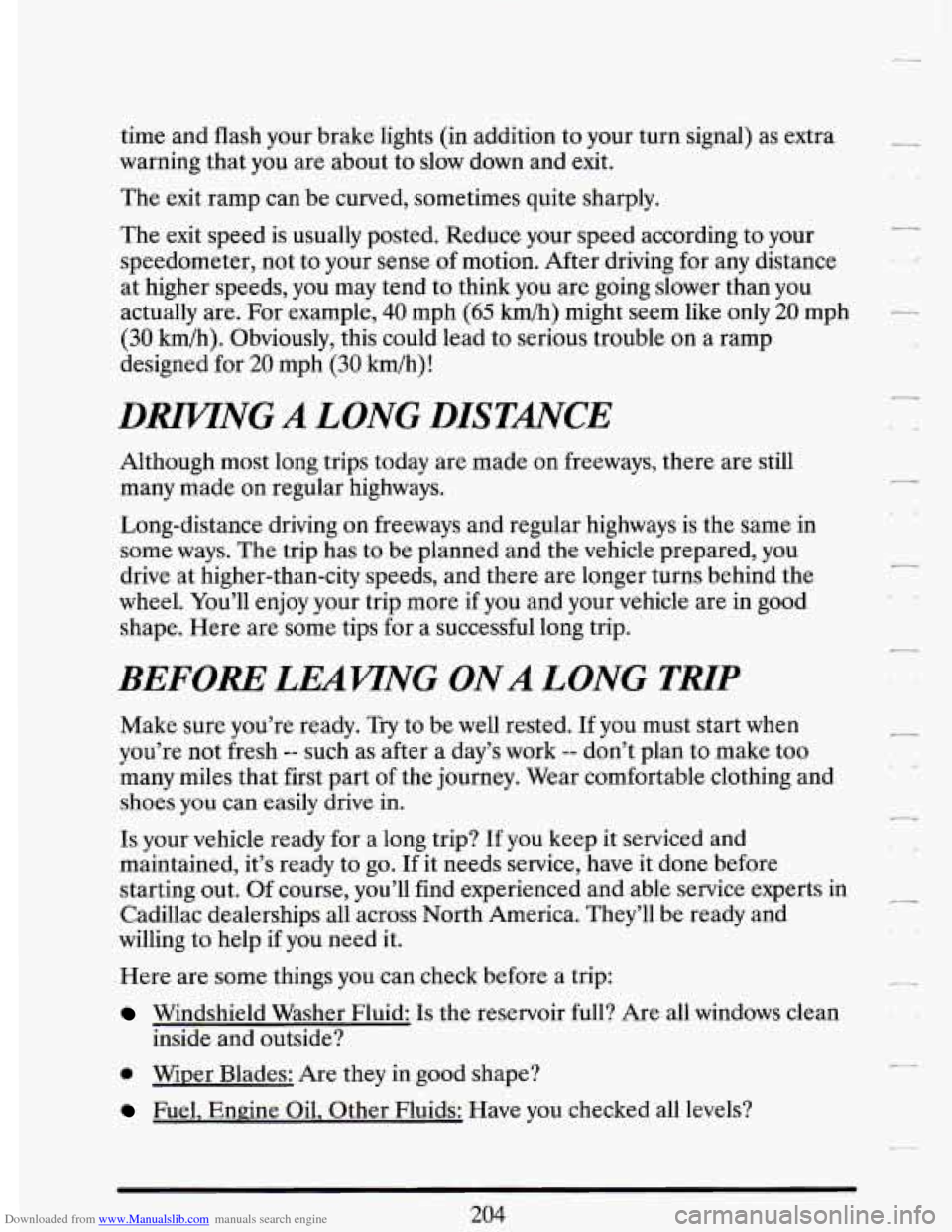warning CADILLAC DEVILLE 1993 7.G Owner's Manual
[x] Cancel search | Manufacturer: CADILLAC, Model Year: 1993, Model line: DEVILLE, Model: CADILLAC DEVILLE 1993 7.GPages: 406, PDF Size: 20.78 MB
Page 206 of 406

Downloaded from www.Manualslib.com manuals search engine surfaces because stopping distance will be longer and vehicle control
more limited.
While driving on a surface with reduced traction, try your best to avoid
sudden steering, acceleration, or braking (including engine braking by
shifting to
a lower gear). Any sudden changes could cause the tires to
slide. You may not realize the surface is slippery until your vehicle is
skidding. Learn to recognize warning clues
-- such as enough water, ice or
packed snow on the road to make a “mirrored surface”
-- and slow down
when you have any doubt.
Remember: Any anti-lock braking system
(ABS) helps avoid only the
braking skid. Steer the way you want to go.
DRIPTNG AT NIGHT
Night driving is more dangerous than day driving. One reason is that
some drivers are likely to be impaired
-- by alcohol or drugs, with night
vision problems, or
by fatigue.
Here are some tips on night driving.
0 Drive defensively. Remember, this is the most dangerous time.
0 Don’t drink and drive. (See “Drunken Driving” in the Index for more
on this problem.)
193
Page 213 of 406

Downloaded from www.Manualslib.com manuals search engine I I
Start your windshield wipers and washer, to help clear accumulated road
dirt. Slow down carefully.
Tips on Driving in Fog
If you get caught in fog, turn your headlights on low beam, even in
daytime. You’ll see -- and be seen -- better.
Don’t use your high beams. The light will bounce off the water droplets
that make up fog and reflect back at you.
Use your defogger.
In high humidity, even a light buildup of moisture on
the inside
of the glass will cut down on your already limited visibility. Run
your windshield wipers and washer occasionally. Moisture can build up
on the outside glass, and what seems to be fog may actually be moisture
on the outside of your windshield.
Treat dense fog as an emergency.
Try to find a place to pull off the road.
Of course you want to respect another’s property, but you might need to
put something between you and moving vehicles
-- space, trees, telephone
poles, a private driveway, anything that removes you from other traffic.
If visibility is near zero and you must stop but are unsure whether you are
away from the road, turn your lights on, start your hazard warning
flashers, and sound your horn at intervals or when you hear approaching
traffic.
Pass other vehicles in fog only if you can see far enough ahead to pass
safely. Even then, be prepared to delay your pass if you suspect the fog is
worse up ahead.
If other vehicles try to pass you, make it easy for them.
Page 214 of 406

Downloaded from www.Manualslib.com manuals search engine CITYDlUPTNG
One of the biggest problems with city streets is the amount of traffic on
them. You’ll want to watch out for what the other drivers are doing and
pay attention to traffic signals.
Here are ways to increase your safety in city driving:
0
0
0
Know the best way to get to where you are going. Try not to drive
around trying to pick out a familiar street or landmark. Get
a city map
and plan your trip into an unknown part
of the city just as you would
for a cross-country trip.
Try to use the freeways that rim and crisscross most large cities. You’ll
save time and energy.
(See the next section, “Freeway Driving.”)
Treat a green light as a warning signal.
A traffic light is there because
the corner is busy enough to need it. When a light turns green, and
just before you start
to move, check both ways for vehicles that have
not cleared the intersection
or may be running the red light.
Page 217 of 406

Downloaded from www.Manualslib.com manuals search engine time and flash your brake lights (in addition to your turn signal) as extra
warning that you are about to slow down and exit.
The exit ramp can be curved, sometimes quite sharply.
The exit speed is usually posted. Reduce your speed according to your
speedometer, not to your sense
of motion. After driving for any distance
at higher speeds,
you may tend to think you are going slower than you
actually are. For example,
40 mph (65 kmh) might seem like only 20 mph
(30 krn/h). Obviously, this could lead to serious trouble on a ramp
designed
for 20 mph (30 km/h)!
DmNG A LONG DISTANCE
Although most long trips today are made on freeways, there are still
many made
on regular highways.
Long-distance driving on freeways and regular highways is the same in
some ways. The trip has to be planned and the vehicle prepared, you
drive at higher-than-city speeds, and there are longer turns behind the
wheel. You’ll enjoy your trip more if you and your vehicle are in good
shape. Here are some tips for a successful long trip.
BEFORE LEAWNG ONA LONG TMP
Make sure you’re ready. Try to be well rested. If you must start when
you’re not fresh
-- such as after a day’s work -- don’t plan to make too
many miles that first part of the journey. Wear comfortable clothing and
shoes you can easily drive in.
Is your vehicle ready for a long trip? If you keep it serviced and
maintained, it’s ready to go. If it needs service, have it done before
starting out.
Of course, you’ll find experienced and able service experts in
Cadillac dealerships all across North America. They’ll be ready and
willing to help if you need it.
Here are some things you can check before a trip:
Windshield Washer Fluid: Is the reservoir full? Are all windows clean
inside and outside?
0 Wiper Blades: Are they in good shape?
Fuel, Engine Oil, Other Fluids: Have you checked all levels?
c
204
Page 226 of 406

Downloaded from www.Manualslib.com manuals search engine Include an ice scraper, a small brush or broom, a supply of windshield
washer fluid, a rag, some winter outer clothing, a small shovel, a
flashlight, a red cloth, and a couple
of reflective warning triangles. And, if
you will be driving under severe conditions, include a small bag of sand, a
piece
of old carpet or a couple of burlap bags to help provide traction. Be
sure you properly secure these items in your vehicle.
Driving on Snow or Ice
Most of the time, those places where your tires meet the road probably
have good traction.
However, if there is snow or ice between your tires and the road,
you can
have a
very slippery situation. You'll have a lot less traction or "grip" and
will need to be very careful.
Page 235 of 406

Downloaded from www.Manualslib.com manuals search engine may think drivers behind you are seeing your signal when they are not.
It’s important to check occasionally to be sure the trailer bulbs are still
working.
Your vehicle has bulb warning lights. When you plug trailer lights into
your vehicle’s lighting system, its bulb warning lights may not let you
know if one
of your lights goes out. So, when you have trailer lights
plugged in, be sure to check your vehicle and trailer lights
from time to
time to be sure they’re all working. Once you disconnect the trailer lights,
the bulb warning lights again can tell you if one of your vehicle lights is
out.
Driving On Grades
Reduce speed and shift to a lower gear before you start down a long or
steep downgrade.
If you don’t shift down, you might have to use your
brakes
so much that they would get hot and no longer work well.
On a long uphill grade, shift down to “3” (Drive) and reduce your speed
to
45 mph (70 km/h) to reduce the possibility of engine and transaxle
overheating.
Parking on Hills
You really should not park your vehicle, with a trailer attached, on a hill.
If something goes wrong, your rig could start to move. People can be
injured, and both your vehicle and the trailer can be damaged.
But if you ever have to park your rig on a hill, here’s how to do it:
1. Apply your regular brakes, but don’t shift into “P” (Park) yet.
2. Have someone place chocks under the trailer wheels.
3. When the wheel chocks are in place, release the regular brakes until
the chocks absorb the load.
4. Reapply the regular brakes. Then shift into “P” (Park) firmly and
apply your parking brake.
5. Release the regular brakes.
222
Page 238 of 406

Downloaded from www.Manualslib.com manuals search engine _HAZARD WMING FLASHERS
'/
..
Your hazard warning flashers let you warn others. They also let police
know you have a problem. Your front and rear turn signal lights will flash
on and
off.
Press the button in to
make your front and
rear turn signal lights
flash on and
off.
I
Your hazard warning flashers work no matter what position your key is in,
and even if the key isn't in.
Page 239 of 406

Downloaded from www.Manualslib.com manuals search engine I
'*
m- - - To turn off the
flashers, pull out
on
the collar. When the
hazard warning
flashers are
on, your
work.
.L 5;$+ ~ turn signals won't .&A'<,,,
OTHER WMING DEWCES
If you carry reflective triangles, you can set one up at the side of the road
about
300 feet (100 m) behind your vehicle.
JUMP STARTING
If your battery has run down, you may want to use another vehicle and
some jumper cables
to start your Cadillac. But please follow the steps
1 below to do it safely.
Batteries can hurt you. They can be dangerous because:
a They contain acid :- at can b7 n you.
0 They contain a that can explode or ignite.
a They contaih enough electricitv to burn you.
If you don't follow these steps exactly, some or all of these things
can hurt you.
-
c -Y
-
Cr
-
c- c
226
Page 245 of 406

Downloaded from www.Manualslib.com manuals search engine TOMNG YOUR mHICLE
Try to have a GM dealer or a professional towing service tow your
Cadillac. The usual towing equipment
is a sling-type, or a wheel-lift, or
car carrier tow truck.
CAR CARRIER
.
SLING-TYPE
WHEEL LIFT
.
J
n
J
V
7
If your vehicle has been changed or modified since it was factory-new by
adding aftermarket items like fog lamps, aero skirting, or special tires and
wheels, these instructions and illustrations may not be correct.
Before you do anything, turn on the hazard warning flashers.
When you call, tell the towing service:
That your vehicle cannot be towed from the front with sling-type
That your vehicle has front-wheel drive.
The make, model, and year of your vehicle.
Whether you can still move the shift lever.
If there was an accident, what was damaged.
equipment.
232
Page 249 of 406

Downloaded from www.Manualslib.com manuals search engine ENGINE 0VERH.EATING
YOU will find the two warning lights about a hot engine on your Cadillac
instrument panel.
If Steam Is Coming From Your Engine:
A CAUTION:
Steam from an overheated engine can burn you badly, even if
you just open the hood. Stay
away from the engine if you see or
hear steam coming from it. Just turn it
off and get everyone
away from the vehicle until it cools down. Wait until there is no
sign
of steam or coolant before opening the hood.
If you keep driving when your engine is overheated, the liquids
in it can catch fire. You or others could be badly burned. Stop
your engine if it overheats, and get out
of the vehicle until the I
1-
l-
engine is cool.
I I